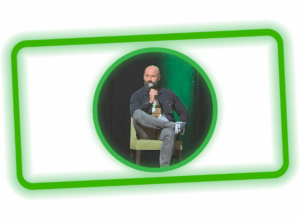In 1985, Karel Schelfhout founded the Super Sativa Seed Club (SSSC). In the late 1980s, along with Nevil Schoenmakers’ Seed Bank, the SSSC helped to found the international cannabis seed trade in Holland.
In the 1980s, Karel was part of the Dutch squatter scene when he decided to start growing cannabis. After a less than successful attempt growing imported equatorial ‘Sativas’ in the cold wet climate of the Netherlands, Karel noticed an advertisement in a High Times magazine for the Seed Bank. Karel wrote the Seed Bank to place an order. According to Karel, Nevil told him that he was the first person in Holland to reach out to buy seeds. Nevil invited Karel to come to meet him and see his operation.
Karel met Nevil who showed him the Seed Bank operation. At this time Nevil was having difficulty keeping up with demand and Karel initially started making seeds for Nevil. This, however, did not last long, after a dispute arose Karel decided to branch out and start his own seed company and Super Sativa Seed Club was born.
THE EARLY YEARS OF THE SUPER SATIVA SEED CLUB
This early, albeit short-lived, partnership with Nevil and the Seed Bank provided Karel with both the knowledge and genetics needed to found and successfully operate the SSSC. One of the more notable varieties that Karel received from Nevil was the Northern Lights No.5 which the Super Sativa Seed Club called ‘Basic 5’ and sold in hybrid with Skunk No.1 (m39).
Shortly after the SSSC began operating, Karel was contacted by the American David Watson who had recently immigrated to Holland. Karel met with David Watson and received a number of important seed lines including the Afghani No.1, Skunk No.1, and Haze. These lines were quickly incorporated into the SSSC’s offerings. Karel credits Watson with being one of the first true cannabis breeders for his work stabilizing the Skunk No.1 line.
These heavily worked breeding lines sourced from Nevil and Watson became the backbone of much of SSSC offerings. In addition to this breeding stock SSSC also worked with a number of imported varieties from traditional centers of production and places of origin from around the world such as Nepal, Afghanistan, Africa, South Indian, Thailand, and Mexico. One of the more well-known of these lines was the Durban (m3), and the Durban Thai Highflyer (m8).
The SSSC introduced the use of seed catalogs with color photographs and their own unique alphanumeric system that listed every variety with an ‘m’ and a number (e.g. m1-m45). Nevil quickly followed suit and produced his own color Seed Bank catalog.
Initially, the tricky logistics and lack of trust limited sales for the Super Sativa Seed Club. For example, prospective seed buyers had to send a letter purchasing a seed catalog and then send money for their seed order upfront before their seeds would be sent.
All of that changed after High Times published the September 1987 issue featuring SSSC on the cover of the 2nd Annual Indoor Growing Guide. Inside the magazine, SSSC was featured prominently in many of the articles on indoor growing. The Super Sativa Seed Club was also the subject of a full-length article written by High Times editor Steven Hager complete with a centerfold picture of the SSSC’s Durban Poison by High Times photographer Jeff Vaughn.
SSSC provided indoor cultivation tips such as suggesting that growers adopt what they called the “plantlet method” which became commonly referred to as Sea-of-Green (lots of short tightly packed clones with a single vertical shoot and little side branching) as a way of increasing commercial production in an indoor space.
After receiving the High Times stamp of approval – which back then was actually worth something – SSSC’s business exploded, particularly in the US.
SSSC, like The Seed Bank, relied on a series of domestic distributors in the United States who performed the task of order fulfillment. Among SSSC’s American distributors was Mr. Soul, who would later go on to found and operate Brother Grimm Seeds, and the online forum user ‘OldSSSCguy’ who still frequents ICmag and Overgrow to this day.
In July of 1990, federal prosecutors in Louisiana brought a 44-charge indictment against Nevil Schoenmakers that carried a potential penalty of multiple life sentences.
By the end of 1990, the SSSC closed up shop and shut down operations as an international seed company. After five years operating as the second-largest seed company in the world SSSC simply vanished.
For years after their sudden disappearance, the Super Sativa Seed Club was a bit of an enigma remembered only through obscure references in a few old High Times (1985-1990), fragments of the old SSSC seed catalogs, and the few remaining clones and seeds in circulation.
Thankfully over the years people like @akbeanbrains, ‘OldSSSCguy’ (ICmag and Overgrow) as well as others have preserved and reproduced complete copies of these catalogs for posterity. In addition to being a useful marketing tool for commercial seed companies, seed catalogs are also important historical documents recording commercially available varieties offered by particular seed companies at specific times.
After closing SSSC, Karel continued to operate as a small-scale underground cannabis cultivator. Karel claims to have continued commercially cultivating his own select phenotype (Karel’s Haze) selected from a large population of the original Haze x Skunk No.1 cross he made with seeds directly from David Watson back in the mid-80s.
In recent years, however, Karel and his son, Kees, have restarted SSSC and have begun selling seeds once again. Many of the new SSSC seed lines are based on hybrids of the Karel Haze.
Some of the original SSSC lines live on in both pure and hybridized forms in the work of other breeders. Fleur De Mar seeds offers a SSSC Durban-Thai Highflyer (m8) x Cindy-99.
@cricketsandcicadas have worked extensively with the Afghan No.1 (m10) making numerous outcrosses and maintaining the line through open pollination.
Bodhi has just recently offered up some new Williams Wonder (m31) crosses.
@thefarmaok has also worked with a number of SSSC lines including the Friesland Indica (m33) and the Durban (m3).
From 1985 to 1990 the Super Sativa Seed Club and the Seed Bank distributed millions of seeds of many of the foundational early modern hybrids (primarily sourced from American breeders) around the globe. These genetics were the backbone of the Dutch seed industry and they would go on to help found the seed industries that would emerge in Canada and the United States in the following decades.
The Super Sativa Seed Club helped found the international cannabis seed trade and ignite the indoor and homegrown revolution that came to shape much cannabis cultivation and culture during the era of prohibition.

















